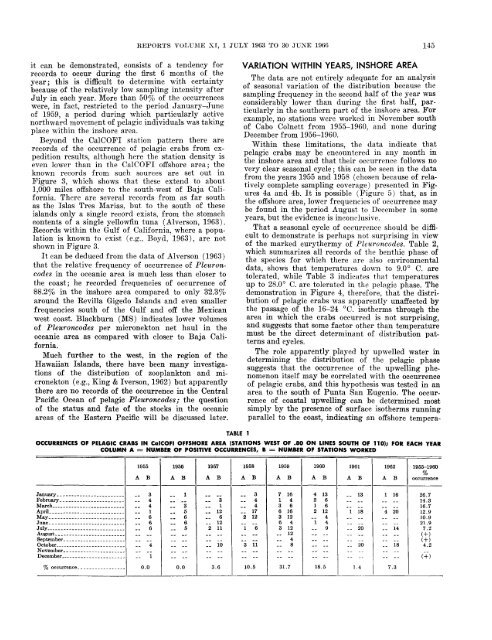CalCOFI Reports, Vol. 11, 1967 - California Cooperative Oceanic ...
CalCOFI Reports, Vol. 11, 1967 - California Cooperative Oceanic ...
CalCOFI Reports, Vol. 11, 1967 - California Cooperative Oceanic ...
You also want an ePaper? Increase the reach of your titles
YUMPU automatically turns print PDFs into web optimized ePapers that Google loves.
REPORTS VOLUME SI, 1 JULY 1963 TO 30 JUNE 1966 145it can be demonstrated, consists of a tendency forrecords to occur during the first 6 months of theyear ; this is difficult to determine with certaintybecause of the relatively low sampling intensity afterJuly in each year. More than 50% of the occurrenceswere, in fact, restricted to the period January-Juneof 1959, a period during which particularly activenorthward movement of pelagic individuals was takingplace within the inshore area.Beyond the <strong>CalCOFI</strong> station pattern there arerecords of the occurrence of pelagic crabs from expeditionresults, although here the station density iseven lower than in the <strong>CalCOFI</strong> offshore area; theknown records from such sources are set out inFigure 3, which shows that these extend to about1,000 miles offshore to the south-west of Baja <strong>California</strong>.There are several records from as far southas the Islas Tres Marias. but to the south of theseislands only a single record exists, from the stomachcontents of a single yellowfin tuna (Alverson, 1963).Records within the Gulf of <strong>California</strong>, where a populationis known to exist (e.g., Boyd, 1963), are notshown in Figure 3.It can be deduced from the data of Alverson (1963)that the relative frequency of occurrence of Pleuroncodesin the oceanic area is much less than closer tothe coast ; he recorded frequencies of occurrence of88.2% in the inshore area compared to only 32.370around the Revilla Gigedo Islands and even smallerfrequencies south of the Gulf and off the Mexicanwest coast. Blackburn (MS) indicates lower volumesof Pleuroncodes per micronekton net haul in theoceanic area as compared with closer to Baja <strong>California</strong>.Much further to the west, in the region of theHawaiian Islands, there have been many investigationsof the distribution of zooplankton and micronekton(e.g., King & Iverson, 1962) but apparentlythere are no records of the occurrence in the CentralPacific Ocean of pelagic Pleuroncodes; the questionof the status and fate of the stocks in the oceanicareas of the Eastern Pacific will be discussed later.VARIATION WITHIN YEARS, INSHORE AREAThe data are not entirely adequate for an analysisof seasonal variation of the distribution because thesampling frequency in the second half of the year wasconsiderably lower than during the first half, particularlyin the southern part of the inshore area. Forexample, no stations were worked in November southof Cab0 Colnett from 1955-1960, and none duringDecember from 1956-1960.Within these limitations, the data indicate thatpelagic crabs may be encountered in any month inthe inshore area and that their occurrence follows novery clear seasonal cycle ; this can be seen in the datafrom the years 1955 and 1958 (chosen because of relativelycomplete sampling coverage) presented in Figures4a and 4b. It is possible (Figure 5) that, as inthe offshore area, lower frequencies of occurrence maybe found in the period August to December in someyears, but the evidence is inconclusive.That a seasonal cycle of occurrence should be difficultto demonstrate is perhaps not surprising in viewof the marked eurythermy of Pleuroncodes. Table 2,which summarizes all records of the benthic phase ofthe species for which there are also environmentaldata, shows that temperatures down to 9.0" C. aretolerated, while Table 3 indicates that temperaturesup to 28.0" C. are tolerated in the pelagic phase. Thedemonstration in Figure 4, therefore, that the distributionof pelagic crabs was apparently unaffected bythe passage of the 16-24 "C. isotherms through thearea in which the crabs occurred is not surprising,and suggests that some factor other than temperaturemust be the direct determinant of distribution patternsand cycles.The role apparently played by upwelled water indetermining the distribution of the pelagic phasesuggests that the occurrence of the upwelling phenomenonitself may be correlated with the occurrenceoQ pelagic crabs, and this hypothesis was tested in anarea to the south of Punta San Eugenio. The occurrenceof coastal upwelling can be determined mostsimply by the presence of surface isotherms runningparallel to the coast, indicating an offshore tempera-TABLE 1OCCURRENCES OF PELAGIC CRABS IN CalCOFl OFFSHORE AREA (STATIONS WEST OF .80 ON LINES SOUTH OF <strong>11</strong>0); FOR EACH YEARCOLUMN A = NUMBER OF POSITIVE OCCURRENCES, B = NUMBER Of STATIONS WORKEDI1959 1960 1961 1962 1955-1960%A1956 B r BA B A B A B A B occurrence? 161 43 66 163 126 43 12_- 12-- 4__ 8__ ____ __31.7 18.5 I 1.4 I 7.3 I26.714.316.712.910.921.97.2(+)(+)4.2(T,















